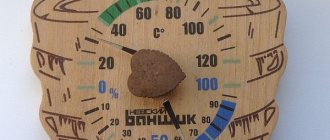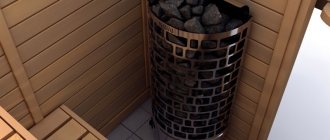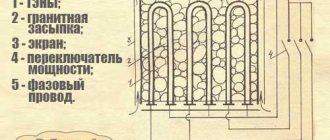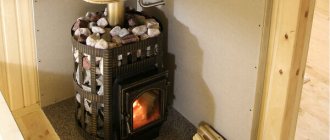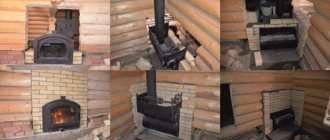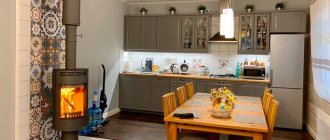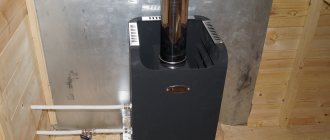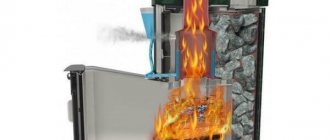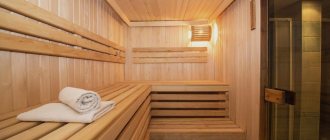If you want to quickly build a sauna, and conditions do not allow the use of wood-burning or gas stoves, then the best option is to purchase a ready-made electric heater for saunas. It will save you from problems with fuel, and it can be used in any room.
>
Electric sauna stove
Electric sauna stove: how to choose?
But it won’t be a matter of choice, you just need to get a sufficient understanding of what a sauna stove is, what types the market offers, and how to take into account the features of an existing steam room when purchasing. We will try to provide comprehensive information on each of the points.
And we’ll start, perhaps, by answering the question about what types of electric stoves there are:
By voltage: 220V or 380 volts
The voltage in a regular household electrical network is 220 volts. Therefore, most buyers are interested in their furnace operating from such a network. This would save them additional hassle and expense.
However, in practice, the voltage consumed is directly dependent on the power of the purchased unit. And the power, in turn, depends on the volume of the heated room . It follows from this that the owner of a large family or family-guest sauna does not have to count on cutting costs - a large stove will need a 380-volt network.
IMPORTANT! Typically, sauna stoves that consume 220 volts have a power of no more than 7 kW. This is enough for a small and even medium-sized steam room.
Electric heater SAWO MINI MN-23NB-Z. Photo by SAWO
You can bring 380 volts into a house or apartment - it’s not particularly difficult, you just need to take three instead of one phase. Difficulties arise with permits and with replacing wiring (it must be thicker than usual). Well, don’t forget that you will have to pay more for electricity bills, but this does not depend on the network itself, but on energy consumption.
By the way, you can easily install a three-phase 380 volt network in private homes - not everyone knows, but this issue is resolved at the request of the consumer.
Let's name several models of each subspecies:
Electric sauna heaters 220 volts – Helo CUP 45 ST, Sawo Mini MN-23 NB-Z, Harvia Vega Compact BC 23, Tylo Compact 2/4, Polytech-M PEN-2m.
Electric sauna heaters 380 volts – EOS 34 A, Harvia Virta HL 90, Tylo SD 20, Helo Seidankivi Seita 1052, Polytech “Christina” with ENU-18i evaporator.
Keep in mind! In the characteristics of some furnaces there is a mention of the possibility of connecting to both single-phase and three-phase networks - “220/380”.
Electric sauna stove Harvia Trendi KIP (220v and 380v)
With and without a steam generator
Another interesting point: do you need a stove with a steam generator in a sauna? After all, a sauna is called a “dry air bath” for a reason – there is little steam in it, the main “ingredient” is dry heat, which makes a person sweat (and convection is responsible for evaporation). How will he sweat if the humidity in the bathhouse increases?
Do you know, for example, why in Japan at 30 degrees the heat is considered unbearable, but in continental Asia even at 50 degrees people continue to calmly go to work? Because high humidity does not allow sweat to evaporate from the surface of the body, and it does not cool it (continental air is much drier than island air). The result is overheating, heart problems and other related ones.
IMPORTANT! You need to be careful with the steam generator in the sauna. Lower the temperature if you want more steam. And for an ordinary sauna, the steam produced by a regular heater, which is available in all electric models, is quite suitable.
However, sometimes a steam generator is necessary. For example, when we are talking about a heater that can operate in the “sauna” and “Russian bath” modes. Of course, it will be a surrogate, but it will be fast. The heater will almost instantly heat the bath to 60 degrees, and the steam generator will produce (if it can) fine steam.
BY THE WAY! Couples are different. There is a low-temperature one - you usually see it above pots and kettles. It is white and thick, and heavy on the body. There is superheated steam - it is almost invisible, it is light, and this is what your steam generator should be able to produce.
Steam generators are also different: built-in and separate. Here are some models.
Steam generator Helo HNS 34 T1
Separate:
- Sawo STP-90-C1/3 SST,
- Harvia HELIX HGX 2,
- Helo HNS 34 T1,
- Tylo Steam 2/4/6 VB,
- HygroMatik CompactLine C06-CDS,
- Sturm Etna 3 Pietra,
- EOS SteamTec Classic.
Built-in : all models with the word Combi in the name.
Electric stove for mini-sauna
A mini-sauna is a very small room (from 1.5 cubic meters), designed for one or two people steaming at the same time. Recently, it has become fashionable to arrange these right in city apartments.
Pleasant things are combined with useful things. A mini-sauna does not consume much electricity, and you can even make it yourself. The main thing is to take good care of thermal insulation.
What kind of stove can be used for a mini-sauna? Of course, also tiny. By the way, sometimes manufacturers put the word Mini or Compact in the name of such products. Here are examples of some models that you will find on the market:
Sawo – Mini and Mini-X series (see photo above). Harvia – Vega Compact, Delta, etc.
Harvia Delta D23 oven. Harvia Photos
By place of production: Finnish electric furnaces and all others
Who is considered the best manufacturer of sauna stoves? Of course, those who understand the intricacies of this bathhouse better than others. And in this regard, the Finns have practically no competitors - this is their national pride, which they are happy to export to the whole world. But exporting is always expensive.
Here are the names of companies that are popular in the market:
- Finland – Helo, Sawo, Harvia (a separate article is devoted to electric heaters from this manufacturer), Narvi.
- Sweden – Tylo.
- Germany – EOS.
- Russia – Inzhkomtsentr, Polytech, fuel and energy complex.
According to the material of electric heaters: tape and tubular
Well, of course, the ovens themselves are not belt or tubular. We are talking only about the design of the heating elements, which can be either in the form of tubes or in the form of a ceramic tape. Tubular shells are usually made of metal.
Tubular heater
IMPORTANT! Tubular electric heaters are quite fragile and easily fail. They can be damaged by stones that are placed too tightly (when heated, the stone expands), or simply by a random movement that bends the heating element at the base. See the article about the correct placement of stones in an electric heater.
Today, most electric heaters are equipped with tubular elements. The reason may also be a reduction in cost. But this is not the best option for the consumer. They are not as economical as tape ones. The latter also burn less oxygen!
Electric sauna stove, strip. Photo source
On a note! When calculating power, take into account that strip elements with equal power heat one and a half times the volume.
Useful video
Also watch a video about choosing electric stoves for a sauna from different points of view:
Assembly technology
To assemble an electric sauna heater with your own hands, you need to follow these steps:
- First, a drawing of the future furnace is drawn up, which depends on the following data: furnace area, required heating power, maximum and minimum dimensions, location. Typically, electric furnaces are made small; the main space of their design is a cage for stones.
- Calculation of the number of heating elements for the furnace. Their number depends on the power of the future design, the size of the furnace, and the power of one heating element that will be used.
- After this, you can begin assembling the sauna stove. To do this, heating elements are fixed on the frame and connected by jumpers. A sheet of steel with a thickness of 3 mm is used as a base, and other parts are attached to it using bolts and welding.
- If the frame is ready, it is necessary to lay the stones on top as tightly as possible, there should be almost no gaps between them.
- Next, a protective casing is installed, which can also be made of steel sheet, like the main structure. Additionally, you can put up a brick wall, providing for this the construction of a small pedestal for the stove.
- The connection of the electric furnace is carried out using serial, parallel connections of heating elements; it is necessary to have a thermostat, with the help of which the heating of the stones will be controlled. In this case, it is recommended to use rotary or drum switches; the control element itself must be positioned so that it is in a place convenient for use. Usually the regulator is placed in the steam room so that you can independently set a comfortable temperature in the room without leaving it.
- The last step is to check the functionality of the stove, the safety and comfort of its use.
We invite you to familiarize yourself with: Scandinavian style bathhouse
Today, for small home saunas, it is best to use not massive brick stoves, which take up a lot of space, but small and compact, but convenient electric ones. The cost of such structures can be quite high, but you can save money by installing an electric furnace for heating stones with your own hands. The technology for its production is accessible. This is a cage for stones, in which heating elements are used for heating.
1. We draw up graphic images of the future design, determine the dimensions of the room, which will determine the size of the furnace, location, and required power. Standard electric furnaces do not have large dimensions; they are very compact.
2. We calculate the number of heating elements. Their number will depend on the required power of the furnace, its dimensions, as well as the power of one electric heater used.
Diagram of an electric heater with heating elements
3. We assemble the electric heater itself. The heating elements are fixed to the frame and connected using jumpers. A pre-prepared steel sheet with a thickness of about 3 mm is fastened with bolts or welding.
4. We lay the stone filler tightly so that the stones are located tightly, without cracks or gaps.
5. Install the protective casing. It can be made of the same material as the base for the stove - sheet steel. You can also install a brick wall that performs the same protective function.
6. The electric furnace should be connected using parallel and series connections of heating elements. A necessary design element is a thermostat, using which you will regulate the heating of the stones. The use of drum or rotary switches is recommended.
7. The final stage is checking the serviceability of the furnace, operational safety and ability to perform all specified functions.
Obviously, today it is appropriate to use electric stoves for baths or saunas that do not have a large area. A massive brick stove is too bulky for small spaces. In addition, stoves that use wood fuel require too much maintenance. Since the cost of electrical structures is quite high, you can save a lot by making an electric furnace yourself.
Healthy? Save it to your wall! Thank you for like!
Rating of electric sauna stoves
Well, we looked at a number of models based on various criteria. It would be a good idea to bring the information together to make it easier for the reader to make their choice. Therefore, we decided to invite users to take part in compiling a rating, this time of electric sauna stoves.
For our part, we have selected a list of the most popular manufacturers, because it is important to know who you can trust, and the parameters of the steam room and the needs of all consumers are different, it is not possible to take them all into account. But with our joint efforts we can easily help beginners with their choice.
Now is the time to move on to practical issues. Let's start with those that are asked by those sauna owners who have already decided to buy an electric heater. They need to know how to choose a stove with the right parameters.
Power calculation
It is easier to calculate the power of an electric stove than a wood stove. The manufacturer indicates the power in kilowatts in the passport. The consumer can only determine the volume of his steam room in order to get his bearings. But! There is a formal volume, and there is an adjusted volume after adding coefficients - for example, for surfaces without thermal insulation, for heating adjacent rooms in winter, etc.
So, tiles, glass, stone - you need to calculate their surface area, multiply by 1.2 and add to the formal volume.
the glass door to the steam room separately - just add an extra one and a half cubes to the existing numbers.
Then it’s simple: for one kilowatt of stove power - one cubic meter of steam room space, if the stove has heating elements , and one and a half cubic meters if there are tape heaters .
Features and principle of operation
An electric oven is a device consisting of a housing, a thermal insulation layer and a heating element (usually a heating element) . In some cases, tape heaters may be used. They are much more durable, unlike heating elements, and do not burn oxygen as much.
There are also combined models, but their cost is much more expensive. On the outside of the case you can see special metal plates with channels for air circulation. The body itself is filled with stones. Steel screens, which are placed one after another, act as a thermal insulation layer.
This device operates from an electrical network of 220 Volts..
IMPORTANT! The main condition for safe, normal operation is that the outlet must be installed in a dry place. That is why all models are equipped with a long cable that extends outside the steam room.
The principle of operation of such furnaces is simple: the heating element heats the stones inside the chamber, from which heat emanates . Due to this, such devices received the name “electric heater”.
The stove can be installed either on the floor or mounted into the wall. Many modern models can be mounted in both of these ways.
Most electric furnaces are designed for “dry” steam . If you add too much water to it, this can lead to breakdown of the heating elements. Therefore, many manufacturers equip their stove models with special steam generators, thanks to which you can achieve the “Russian bath” effect.
Dimensions
The smaller the sauna, the more important the size of the stove becomes. Low-power heaters are usually very modest in size. An example is the Harvia Compact stove - its width is 24.5-30 cm, depth 22 cm, height 54 cm. It weighs only 9 kg (without stones). Another model from the same company - Vega Compact - weighs even less: 7 kg and has dimensions: 28x29.5x50.5 cm.
IMPORTANT! Information on sizes is essential for selection, therefore it is always indicated in catalogs.
Yes, and one more interesting point : ovens of the same size (within the same line) can have different power. This allows the manufacturer to reduce production costs, and the consumer to choose a standard-sized heater for the volume of the steam room.
Further information will be useful to those who have already purchased a stove and need information on how to properly install and connect it.
Installing an electric stove in a sauna
Of course, an electric heater is not nearly as demanding as a wood-burning (and even more so a brick) stove. It does not need a foundation or a chimney ; many models can be mounted on the wall, and some can even be hung from the ceiling! However, some preparation is still necessary.
For your information! Did you know that some heater models can be installed directly into the bottom shelf? This significantly saves space, and the shelf is protected by a special flange made of steel or other material, which can be purchased along with the stove.
Where the heater will stand, it is better to lay out the floor with tiles or otherwise make it non-flammable (put a sheet of metal, for example). A suspended structure does not need this.
You will find the minimum distances to the main surfaces in the stove data sheet . Usually they are small, but they should be observed exactly or upward.
But if practically no questions arise regarding the installation of the furnace itself, then the same cannot be said about its connection.
Connecting an electric stove in a sauna
The fact is that each sauna owner must independently take care of grounding the purchased unit. If you are not particularly versed in electrics, then entrust the connection to professionals , it is worth it.
It was already mentioned above that electric heaters come with different voltages. For those that can be connected to a regular network, nothing needs to be changed in the wiring. But for those with a voltage of 380, you already need to stretch a cable of the appropriate quality and thickness .
So, grounding. It is better to make its circuit separate for the sauna, rather than using the circuit of the distribution panel . This is not so difficult - the Internet is full of information on how to make a ground loop yourself. It is preferable to conduct the core through cable channels.
In addition, we can recommend connecting the stove to the network not directly, but through a device that ensures that the electrical appliance is turned off if a short circuit occurs or the air in the steam room gets too hot. Such a device will not be needed if a differential circuit breaker with a leakage current of 30 mA is installed.
Most models provide a choice of built-in or remote control panel. In the second case, you will have to take care of connecting the remote control. Typically, owners place it either at the door or in an adjacent room.
IMPORTANT! The remote control needs a circuit breaker in the distribution panel. Look at the stove data sheet to find out the current load. In accordance with it, the denomination of the machine is selected.
Electric furnace sensors allow you to monitor and control the heat. They also require installation, but all its points must be described in detail in the installation instructions for your stove.
IMPORTANT! Do not use intermediate connections, or extend or twist sensor wires.
A separate question is what wires can be used to connect the electric heater. If the stove is designed for 220 volts, then the wires will be three-wire, if for 380 - five-wire. An important issue is the sheath of such wires. The fact is that vinyl is in no way suitable for your purposes. It is correct to use rubber-insulated wiring that is not afraid of high temperatures.
*** So, we will consider that the short course for the future owner of an electric heater is completed. I wish you health and a pleasant stay in your own sauna!
Elektrokamenka: reviews
Gvozdiy Alexander Alekseevich, Riga:
To make a heater, it is better to take not stainless steel, but medical metal, the one that is used for making sterile portable tool boxes. This is an alloy based on nickel and copper, does not oxidize, heats up in just a few minutes, and can withstand any steam, even the hottest. Only the mesh needs to be placed inside so that the stones do not scratch the walls. I had a purchased electric heater in my bathhouse, it took half an hour to heat up, and it smelled like burnt brake pads.
Vitaly Kuznetsov, Zelenograd:
An electric heater with a steam generator must be raised to a height of at least a meter above the bathhouse floor. It doesn't have much power, and by the time the steam room warms up, you'll freeze. And it’s better to brew boiling water in advance, rather than torment the electrical wiring and heaters. The thing is not bad, but it requires skill. You can buy and install it, at least for the fact that the stones are not covered with soot, there is no bitter smell of scale in the bathhouse, like with a wood-burning heater.
Recommended Posts
How to choose the entrance door to a bathhouse
Do-it-yourself bathhouse
Wooden font for a bath
How to get rid of ants and bark beetles in a bathhouse
Closed sauna heater
Building a bathhouse with your own hands
